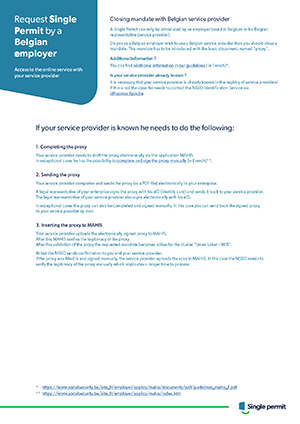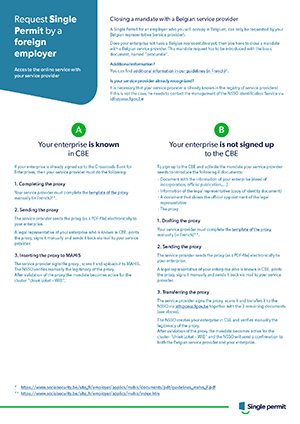A fixed-term single permit
Are you an employer wishing to post a non-European employee to Belgium for more than 90 days? In that case you need to apply for a single permit that will be processed by the competent region. Once your application has been accepted, your employee will receive a single permit permitting him or her to reside in Belgium for work for more than 90 days.
The single permit is a residence permit granted in connection to employment. With a single permit, non-European citizens are allowed to reside in Belgium for work for a period of more than 90 days.
Still, the usual obligations for the employer remain valid. This means you still need to submit a Dimona (in French) declaration for employees who are subject to the Belgian social security system, as well as a Limosa declaration for posted workers.
Are you a Belgian employer wishing to employ a non-European employee? Or are you a foreign employer wishing to employ one of your non-European employees in Belgium?
In both cases you need to apply for a single permit in order to employ a non-European national in Belgium for a period longer than 90 days. This concerns workers having a nationality from outside the European Economic Area (EEA) or Switzerland. Next to the EU Member states the EEA includes Norway, Iceland and Liechtenstein.
Regulations for the employment of foreign employees (work permit B or exemption) remain valid for following workers:
- Workers coming to work in Belgium for a period below 90 days,
- Au pairs,
- Researchers having a hosting agreement,
- Those needing a permission to work in Belgium, without the need for a residency permit. For example, frontier workers and people residing in hotels,
- Workers subject to transfer within an undertaking (Directive 2014/66/EU of 15/05/2014). In this case a work permit B is only provided for a period of up to 90 days, with exemptions only valid for short term mobility,
- Certain apprentices.
The application for a work permit B as well as the single permit with indefinite term will be done in a later phase via the one-stop counter. For current applications you need to follow the valid procedures as described on the site of each region.
- Brussels-Capital Region
Work permit B and single permit with indefinite term - Flemish Region
- Walloon Region (without the German community)
Work permit B and single permit with indefinite term - German Community
The application has to be done by an employer based in Belgium or his Belgian representative. This can be the employer, or a natural person having a main residency in Belgium acting in name and on account of the employer. In case the employer is based outside of Belgium, only this natural person is authorized to act.
Please note: in case you are a Belgian representative you need a mandate from the employer. Mandates can be created using the online service Mahis (in French).
After you have submitted your application using the one-stop counter your dossier is automatically transferred to the competent region.
To find out more about the conditions, procedures and all other required information to submit your application, please consult the website of each region in particular:
- Brussels-Capital Region
- Flemish Region
- Walloon Region (without the German Community)
- German Community (site in German)
In case you are a Belgian employer, you will need to present the National Registration Number of the employee(s) you are applying a single permit for. If you need to look that up, or your employee does not possess a National Registration Number yet, please consult the online service belgianIDpro (in French).
Your employee doesn’t have a residence permit for Belgium yet? In that case the application can be submitted while the employee is still abroad. In certain cases, the application can also be submitted when your employee has been granted a residence for a maximum of 90 days in Belgium (as long as this does not breach any federal or regional regulation on which the application is applicable).
Does your employee already have a Belgian residence permit? In that case you need to submit your application before this residence permit expires.
The employee can only start working after he has received all required documents. This means both the application to work and the application to reside in Belgium have to be approved. All documents can be collected at the municipality office in the place of residence. For detailed information about the specific documents required, please consult the page about Single Permit on the website of the Belgian Immigration Office (in French) or consult the decision provided by the competent region.
Access to the online service with your service provider
Closing mandate with Belgian service provider
A Single Permit can only be introduced by an employer based in Belgium or his Belgian representative (service provider). Do you as a Belgian employer wish to use a Belgian service provider then you should close a mandate. This mandate has to be introduced with the basic document, named “proxy”.
Additional information ?
You can find additional information in our guidelines (in french).
Is your service provider already known ?
It is necessary that your service provider is already known in the registry of service providers! If this is not the case, he needs to contact the NSSO Identification Service via idnl@onss.fgov.be
If your service provider is known he needs to do the following :
1. Completing the proxy
Your service provider needs to draft the proxy electronically via the application MAHIS. In exceptional cases he has the possibility to complete and sign the proxy manually with this template.
2. Sending the proxy
Your service provider completes and sends the proxy (as a PDF-file) electronically to your enterprise.
A legal representative of your enterprise signs the proxy with his eID (identity card) and sends it back to your service provider. The legal representative of your service provider also signs electronically with his eID.
In exceptional cases the proxy can also be completed and signed manually. In this case you can send back the signed proxy to your service provider by mail.
3. Inserting the proxy in MAHIS
Your service provider uploads the electronically signed proxy to MAHIS.
After this MAHIS verifies the legitimacy of the proxy.
After this validation of the proxy the requested mandate becomes active for the cluster “Uniek Loket – WIB”.
At last the NSSO sends confirmation to you and your service provider.
If the proxy was filled in and signed manually, the service provider uploads the scan to MAHIS. In this case the NSSO needs to verify the legitimacy of the proxy manually which implicates a longer time to process.

Access to the online service with your service provider
Closing mandate with Belgian service provider
A Single Permit for an employer who you will occupy in Belgium, can only be requested by your Belgian representative (service provider). Does your enterprise not have a Belgian representative yet, then you have to close a mandate with a Belgian service provider. This mandate request has to be introduced with the basic document, named “procuratie”.
Additional information ?
You can find additional information in our guidelines (in french).
Is your service provider already known ?
It is necessary that your service provider is already known in the registry of service providers! If this is not the case, he needs to contact the NSSO Identification Service via idnl@onss.fgov.be
A. Your enterprise is known in CBE
If your enterprise is already signed up to the Crossroads Bank for Enterprises, then your service provider must do the following :
1. Completing the proxy
Your service provider needs to draft the proxy electronically via the application MAHIS. In exceptional cases he has the possibility to complete and sign the proxy manually with this template.
2. Sending the proxy
Your service provider completes and sends the proxy (as a PDF-file) electronically to your enterprise.
A legal representative of your enterprise signs the proxy with his eID (identity card) and sends it back to your service provider. The legal representative of your service provider also signs electronically with his eID.
3. Inserting the proxy to MAHIS
The service provider signs the proxy , scans it and uploads it to MAHIS.
The NSSO verifies manually the legitimacy of the proxy.
After validation of the proxy the mandate becomes active for the cluster “Uniek Loket – WIB”.
OR
B. Your enterprise is not signed up to the CBE
To sign up to the CBE and activate the mandate your service provider needs to introduce the following 4 documents :
- Document with the information of your enterprise (deed of incorporation, official publication,…)
- Information of the legal representative (copy of identity document)
- A document that shows the official appointment of the legal representative
- The proxy
1. Completing the proxy
Your service provider needs to draft the proxy electronically via the application MAHIS. In exceptional cases he has the possibility to complete and sign the proxy manually with this template.
2. Sending the proxy
Your service provider completes and sends the proxy (as a PDF-file) electronically to your enterprise.
A legal representative of your enterprise signs the proxy with his eID (identity card) and sends it back to your service provider. The legal representative of your service provider also signs electronically with his eID.
3. Transferring the proxy
The service provider signs the proxy, scans it and transfers it to the NSSO via idnl@rsz.fgov.be together with the 3 remaining documents (see above).
The NSSO creates your enterprise in CBE and verifies manually the legitimacy of the proxy.
After validation of the proxy the mandate becomes active for the cluster “Uniek Loket – WIB” and the NSSO will send a confirmation to both the Belgian service provider and your enterprise.
